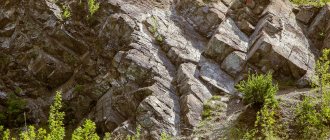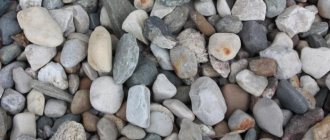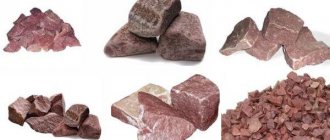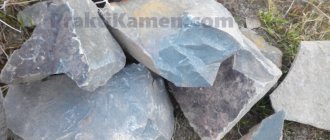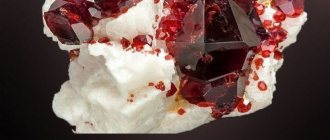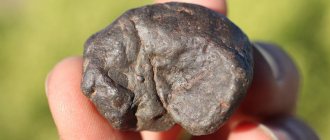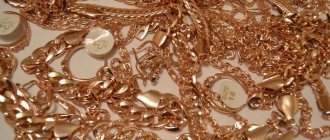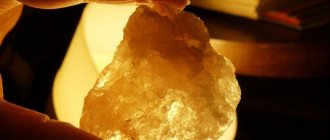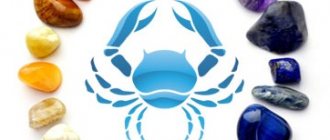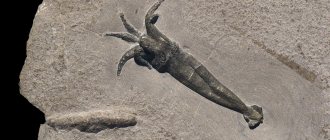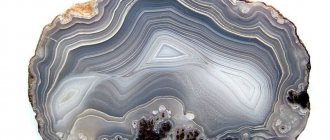About the company / Useful articles / Porphyrite - features of the stone, its properties and varieties
Porphyrite - features of the stone, its properties and varieties
Category: Useful articles
Porphyrite stone is a volcanic rock that does not contain quartz. The paleotype, effusive mineral is used in many fields because it is quite durable and has low thermal conductivity. You can buy porphyrite as a facing or bath material.
Πορφυρίτη (Greek) means purple, but most samples are found in shades of gray and green
Geological certificate
To understand the specifics of using porphyrite in baths and saunas, you need to learn a little more about it.
In general, the composition of porphyrite corresponds to the description of average silica. Like jadeite, the mineral is formed from oxides of silicon, aluminum, magnesium, iron, and calcium. At the same time, the conditions of origin will be completely different. Silica usually forms in the deep layers of the earth for quite a long time, since cooling of magma without air is not a quick process. During this period, crystallization has time to complete.
The porphyrite structure is different. This mineral forms much closer to the surface of the earth. Under these conditions, cooling occurs faster, some crystals completely complete the cycle, others get stuck in the middle. In this case, the completed crystals will be located closer to the center, and the rest will cover them outside, like a capsule. The surface is obtained without an ordered texture and reduced density. As a result, overall hardness suffers.
Depending on the content of the magma, different types of porphyrites are born. The mineral component may be hornblende, pyroxene or plagioclase with a silica content of 45 to 65%.
It is important to distinguish pyroxene porphyrites and pyroxenes, porphyries from porphyrites:
- Pyroxene porphyrites include crystals of pyroxene, but are not entirely composed of it. The strength will be completely different.
- porphyry . Now the term is assigned to silicic acid rocks with potassium spar, and to porphyrites are specimens of the corresponding structure. Therefore, classifying, for example, crimson quartzite as porphyrites is fundamentally incorrect.
Kinds
The stone has a variety of shapes; it is found in nature in the form of domes, oblong needles, and there are also small sections. Rhyolite is rarely found in complex geometric shapes. This is a rare occurrence considering the way it is formed. It is not uncommon to find a mineral with a very large accumulation of ash around the rock or even within the rock itself.
Due to its specificity and formation, liparite is often called volcanic glass (because it contains a large accumulation of volcanic glass due to its origin). This property gives the stone hardness. The average density is achieved up to 5 points on the Mohs scale.
Some scientists draw conditional parallels between rhyolite and granite, since the first stone contains admixtures of other rocks, such as tuffs or volcanic agglomerates. Liparite and granite are often compared, but they have different compositions and different places of formation. The color palette of the rock is wide, the gradient starts from white and reaches pink tints (due to rose quartz). The most common color is sandy yellow with different undertones in the form of green splashes.
The composition of rhyolite impurities also contains the composition of certain natural metals, which gives greater density to the mineral. The stone has a shine and a glassy shell, which gives it smoothness and shimmer in the light. The peculiarities include the fact that rhyolite of any shape can withstand any temperature change, so it is famous for its durability.
Let us list the most common impurities that are found in rhyolite.
- Obsidian – gives the stone a browner tint.
- Pechstein is a volcanic glass, due to which the oily structure of the shine is obtained. Contains shades such as brown, black, green, yellow.
- Pumice. Due to it, porosity and unevenness, bubble inclusions are formed.
- Porphyry or porphyrite is a rock formed from magma. The peculiarity of this stone is that it does not contain potassium feldspar.
Why is porphyrite needed in a bathhouse?
For bathing purposes, the main selection criterion is not the composition of the shell, but the size of the crystals. The smaller they are, the denser the structure and the harder the stone. Such porphyrites distribute temperature fairly evenly, do not crumble for a long time and readily give off heat.
Characteristic colors are gray, pink, white, yellow shades.
Expert opinion
Lovkachev Boris Petrovich
Bath master who knows everything about steaming
A big plus is the reduced radioactivity of the mineral. When heated, it does not release harmful substances into the environment.
So, porphyrite intended for a bath has the following qualities:
- decent resistance to external physical influences;
- resistance to temperature fluctuations;
- fire resistance up to 1350C;
- repels water, sand and dust, easy cleaning.
Most often, stores come across supplies from Siberia, Kazakhstan, Bashkiria, Ukraine, the Caucasus and the Far East. Despite the affordable prices, the mineral is used even in luxury baths.
What is better: gabbro-diabase or granite for a monument?
Both stones are actively used to create monuments. Therefore, you should proceed from two things: firstly, your own taste, and secondly, your wishes regarding the durability of the stone itself and the polishing on it.
Monument made of gabbro-diabase. Photo Karelian gabbro-diabase
As for the taste, we cannot suggest anything: which is better - gabbro-diabase or granite - everyone decides for himself. Granite can be different - from the smallest specks to quite variegated colors. The color range is also wide - shades of pink and red, yellow and brown, as well as black and white variations. There are dark granites with blue or green shades. There are “written” ones - as if covered with ancient writings.
Gabbro-diabase, unlike granite, does not have such a complex and variegated palette. It is either a black stone with small specks (polished) or dark green. It may still be dark grey.
There is another black stone, more beautiful - Labradorite. From a certain angle of view, blue areas flash on it - it looks like the blue glow of a raven's wing.
As for the strength and durability of surface polishing, the advantage, as the masters themselves say, lies with gabbro-diabase.
***
Find out where gabbro-diabase is mined here. We also have a detailed article about its properties. We also have materials about using it in a bathhouse, about the various uses of this stone, about how it is mined and processed.
Benefits and harms
The healing properties of stones always cause a lot of controversy among professional bathhouse attendants. Porphyrite occupies almost a leading position in the number of doubts.
Most steamers tend to believe that porphyrite cannot release any nutrients or aromas. At the same time, it does not emit toxic poisons into the air, which no longer makes the exposure harmful.
The main benefit comes from the effect of steam on the body. The stone is a kind of accumulator of thermal radiation. Other experts and hobbyists claim that the mineral, when heated, infuses a vapor of “vitamins.” In their opinion, in a volatile form, they quickly penetrate the body through the respiratory system and pores on the skin.
A sauna with porphyrite stone is extremely effective in the treatment of respiratory diseases: sinusitis, sinusitis, otitis. The steam created by porphyrite cleanses the skin, heals joints, and creates an atmosphere of mountain freshness in the steam room.
It is not possible to scientifically prove one or another point of view. Therefore, without specifying the reasons, the following effects from being in a bath with porphyrite are noted:
- relaxation of mind and body;
- easier breathing;
- stabilization of normal blood pressure;
- elimination of spasms;
- relief of pain, including headaches, joint and muscle pain;
- improved blood flow;
- increasing immunity.
Contraindications are common for visiting paired procedures: chronic diseases in the acute stage, viral infections, purulent formations, oncology, pathologies of the heart and brain.
Harm from using defective stones is also noted. Pathogenic microorganisms accumulate in cracks and holes, mold and fungi develop. In volatile form, such impurities become most dangerous. In addition, they may not withstand expansion and fly apart, injuring people with fragments.
Therapeutic effect
Practice has confirmed the healing power of the stone:
- The steam emanating from porphyrites makes you feel like a “newborn”. Ailments such as arthritis, radiculitis, migraines, and skin problems go away.
- The stone retains heat for a long time. In contact with the body, it transmits beneficial properties, affecting the body as a whole.
- Massage with balls relieves cellulite, varicose veins, and blockage of blood vessels.
Wearing porphyry products strengthens the immune system, relaxes areas of strong tension, and relieves stress.
Application
Porphyrite is not incredibly beautiful like some other stones. It is not used for laying out decorative inserts, forming entire walls and floors, or for making furniture and interior items. This mineral is not relevant for tactile spa treatments: massages and spot heating.
Mainly, porphyrite has a purely practical value for creating good steam. They line furnace bodies and chimneys. Also, a scattering is made around the heating apparatus and placed directly into the firebox.
In different types of heaters, porphyrite behaves differently:
- closed - the stones do not come into contact with the fire, are placed in a container to isolate them from the flame, covered with a lid or closed with a damper. The heating temperature is about 400C, which implies sharp cooling with water. The steam is light. The service life of porphyrite is 2-3 years depending on the frequency of use.
- direct heating (flow-through) - the fire comes into contact with the stones, and after sufficient heating it is extinguished. Water is poured onto the hot stones. The steam is moist and light. Porphyrite lasts at best 1-1.5 years with moderate use. It is better to place a thick layer of stainless steel under the porphyry. Heating will be slower, but service life will be longer.
- in an open container - a container without a lid or door. The stones are still insulated from the flames. Porphyrite produces heavy steam, since the upper layer does not heat above 100C. In a sauna, such steam spreads more easily due to higher humidity. Service life – 2-4 years.
Wear of porphyrite can be identified by fine dust on the bottom of the heater. When destroyed, it begins to crumble like sand.
Legend
We looked at a variety of maps on which geologists indicate the composition of rocks, and found that there was no single form of symbol for porphyrite . It all depends on its composition. In particular, below we used symbols from the following book (except for the first picture with symbols, it is from a real map):
Here are examples of how it can be designated:
Criterias of choice
Porphyrites with a large amount of sulfides should not be used in baths. They can be identified by their abundant inclusions, reminiscent of dots of metal foil. When such specimens are heated and oxidized, sulfuric acid is released. A thick, suffocating vapor with an unpleasant odor is formed, and soreness and tingling occurs in the throat, eyes, and nasopharynx.
Responsible manufacturers do not put such minerals in packaging, but cases of unscrupulous practices are still common.
You should also pay attention to:
- behavior in water . If you immerse damaged porphyrite in a bowl of water, bubbles will appear around it and on the surface. The more bubbles, the more cavities in the stone.
- manufacturer's certificate and reviews . The presence of a certificate and a large number of good reviews for the brand increase the likelihood of a successful choice.
- sound . With internal cracks, the mineral sounds dull, while a “healthy” one sounds loud. A damaged stone can be identified by tapping the specimens against each other or using a hammer. In the oven, cracked units make a characteristic clicking sound.
Unfortunately, there are many complaints about Karelian stones that they often end up with sulfur impurities.
Speaking of sizes, it is logical to take stones in the range of 5-12 cm. In small kilns, a medium size is placed. In large heaters, fractions alternate layer by layer from bottom to top from the largest to the smallest.
Other characteristics
Table of comparative prices for “budget” heater fillers
| Stone | Average price range (RUB) |
| Porphyrite | 300-400 |
| Gabbro-diabase | 250-450 |
| Soapstone chlorite | 400-550 |
| Raspberry quartzite | 400-600 |
As you can see, the prices are approximately the same, so it’s worth taking what you like. And if you have doubts about the choice, we have a large article that can resolve many doubts.
FAQ
Why is porphyrite placed under semi-precious rocks, since it is more fragile?
Porphyrite in this combination is used as a consumable material. The substrate made from it is cheaper and easier to replace than an expensive stone.
How much porphyrite do you need?
The quantity is calculated according to the recommendations from the instructions for a specific oven. At least 50% filling. You need to take with reserve, taking into account the rejection of individual stones during disassembly.
Which porphyrite is better: diked or chipped?
Regarding porphyrite, it is better to prefer crushed. Its edges are sharper, so there are gaps in the masonry for air and water. This will allow the rock to warm up more efficiently and not overheat to the point of destruction. Expansion due to temperature will occur more evenly.
Do I need to treat stones before putting them in the kiln?
Simply wash in salt or soapy water and dry thoroughly.
Porphyrite is a decent inexpensive stone for creating high-quality steam. With the right mineral, going to a bath or sauna will become a pleasant event without major costs.
History of the stone
The name of the stone is chosen by color. In Ancient Egypt, the rock was mined mainly in the red range, and “porphyres” translated from ancient Greek means “red, purple.”
The rulers of Egypt became the first customers of porphyry products and decor. Craftsmen turned columns, large sculptures, and cladding of buildings and other structures.
Sarcophagus of Frederick II in porphyry, Palermo
Roman patricians and the Greek nobility of Antiquity did not skimp, paying for vases, bowls, and other things pleasing to the eye.
The magical properties of porphyry
Esotericists did not particularly study the magical properties of porphyry, but even four thousand years BC it was an attribute of the ruling class. European monarchs and simply wealthy people continue this tradition, considering the magic of porphyry a guarantee of personal greatness.
Talismans help to absorb knowledge, guide you on the right path, and protect you from bad deeds. The influence of the stone on all zodiac signs is extremely positive.
If you liked the article, share it on social networks. This is important to us, thank you
Tags:What is porphyry and porphyrite: healing and magical properties of the stone
Dye
The Phoenicians were the first to mine porphyry. They collected small, inconspicuous-looking shells from the bottom of the sea, each of which was crushed to obtain just a few drops of thick liquid. This was a wonderful porphyry color paint. For a small vessel filled with such a liquid, weavers would give a whole ingot of silver weighing 8.4 grams. This dye was used to dye the fabric from which clothes were subsequently sewn. A thicker composition of porphyry gave lilac shades, a more liquid one - scarlet colors. The porphyry dye extracted from sea shells was very persistent. Clothing on the fabric of which it was present could be washed every day without loss of color. Military leaders, priests, princes and kings readily bought such robes. This was explained not only by the high quality of the items, but also by the significant cost of fabrics, which have always been a luxury item.
Nowadays, shells that produce porphyry are no longer mined. Fabrics are dyed this color using artificial dye. It turns out much simpler, cheaper and better than the Phoenicians. Nevertheless, this people entered the history of mankind as the discoverer of the porphyry color dye.
Raspberry quartzite
This rock consists of 98% quartz. A valuable and quite rare mineral with a noble purple color. It has high density and low water absorption; in addition, it has the highest hardness, strength and wear resistance. Raspberry quartzite stone is extremely resistant to cracking if it is heated and then cooled.
Crimson quartzite has a noble purple color
This breed is durable and strong, resistant to chemical influences. When used regularly in a sauna stove, it retains its structure and shape, and does not emit toxic impurities when heated.
When you put stones in a sauna stove, keep in mind that individual pieces may crumble. This can be explained by the impact of mechanical processing using the splitting method. As a result, it is necessary to carefully sort the stones before use.
The healing properties of quartz have been known for a long time. It treats diseases of the chest as well as the respiratory tract. In addition, when choosing which stones to choose for a bath, take into account that quartzite stabilizes blood pressure and can improve blood circulation.
White quartz, also called "hot ice"
White quartz is very useful: it saturates the room with ozone
Quartz stone is ideal for baths. It is a translucent white mineral. It is absolutely environmentally friendly.
“Hot Ice” is highly valued for its spectacular appearance and medicinal qualities. Like jadeite, sea bath stones and crimson quartzite, this rock is quite expensive.
Quartz has a unique healing quality: when heated and then sharply cooled by sprinkling with water, it begins to release atomic oxygen, which saturates the room with ozone. This gas enriches the blood of steaming people with oxygen, and also activates brain function and improves well-being.
In addition, as a result of mechanical deformations, which are caused by sudden temperature changes, the “hot ice” crystals begin to emit electromagnetic vibrations. This phenomenon is called the “piezoelectric effect”. These waves, interacting with human electromagnetic fields, correct and restore the body's energy system.
The duration of use of this stone depends on its intensity. It is especially undesirable to expose “hot ice” to very high temperatures typical of a sauna - it will simply burst. It must be regularly sorted out, removing already cracked specimens.
Modern people who value good taste have become accustomed to such phrases as Italian shoes and German cars, Swiss watches and French perfumes. All these products belong to the premium class and are produced by already well-known brands. However, popularity does not come overnight. And the one who today is the leader in the production of this or that product has a long, sometimes even centuries-old history of its development.
However, new stars are constantly appearing in the world of popular brands. One of them was. It is located in Belarus, a country with rich traditions in the production of various goods, and a special, very responsible attitude to work. Today, in the vast expanses of the former USSR, goods made in the Republic of Belarus are highly valued. Whether it’s food or cosmetics, women’s clothing or shoes, the phrase “Made in Belarus” is a kind of guarantor of quality.
What goods does it produce? Women's clothing is its main direction. Fashionable models combine the best practices of the Belarusian light industry and the design school. They are produced only using the most modern technologies.
Four times a year, Porphyra presents new collections to its customers. Clothing for women, made in the European style, is distinguished by an excellent fit and high quality tailoring.
Produced women's clothing encourages transformation. Representatives of the fair half of humanity can only choose impeccable minimalism or extravagant ethnic, always up-to-date classics or bohemian chic. But be that as it may, in clothes from a Belarusian manufacturer a woman will certainly feel inimitable. All models of the presented collections are not those nameless things that trading organizations purchase wholesale and retail. An increasing number of women are becoming fans of the Porphyra brand, and this means the beginning of the history of a new brand. Perhaps, very little time will pass, and Minsk will become one of the links in the famous chain, which includes the most fashionable capitals of the world, such as Paris and Milan, New York, London and Tokyo.
Mantle
The first imperial porphyry in Russia was made in 1724 for the coronation of Catherine I. The weight of this robe was 60 kg. A special clasp was made for the mantle, which cost about one hundred thousand rubles.
Since then, porphyry has become one of the regalia of power in Rus'. This robe looked like a long sleeveless cloak. The upper part of the mantle was decorated with an ermine fur cape, made in the form of a collar. On the back of the porphyry there was an embroidered state coat of arms. All edges of the royal robe were also framed with ermine, the length of which with a train for the emperor was 5 m 67 cm, and for the empress - 4 m 98 cm.
In earlier times, Byzantine porphyry in the form of a tunic was an invariable attribute of the rulers of the Roman state. The purple-colored mantle was the main difference among the Etruscan kings. In addition to emperors, such robes were worn by priests who predicted the future.
Place of Birth
Porphyrites are found in the Urals (Timofeevsky, Argayashsky), the Caucasus, Transcaucasia, Ukraine, Central Asia, Kazakhstan, Altai, Eastern Siberia and the Far East.
In the Chelyabinsk region, not far from the village of Novogorny, there is the Argayash porphyrite quarry, where more than a million tons of rock are mined per year. On the territory of the Republic of Bashkortostan, in the Beloretsk region, the Abzakovsky quarry of pyroxene-plagioclase porphyrites has been developed since 2011.
Category: Bath
Mineral mining
Fossil deposits are extensive. The most popular and studied places are the Deccan Plateau in Hindustan, the plain in Argentina, and Brazil. Minerals are mined in Ireland, Finland, and Russia. In the Russian Federation, deposits are located in the Urals, Altai, and in the region of the East Siberian Upland. In South America, monoliths are characterized by voids in which the amethyst is located.
To ensure that the fossil is not damaged during the extraction process and maintains its structure, gentle methods are used. How the first one works:
- First, a hole is drilled into the mineral.
- Then explosives are placed so that the rock blocks remain at their maximum size after the explosion.
Another option is characterized by changing the bomb to use a hydraulic method. The pit is filled with water under pressure. She tears the rock apart.
The latter option implies that the minerals are mined using a professional stone cutter equipped with a diamond-wire sawing mechanism.
Interesting to know! To extract gabbro monolith, special crushing equipment is used, which at the output will allow you to pick up pieces of different sizes and shapes.
